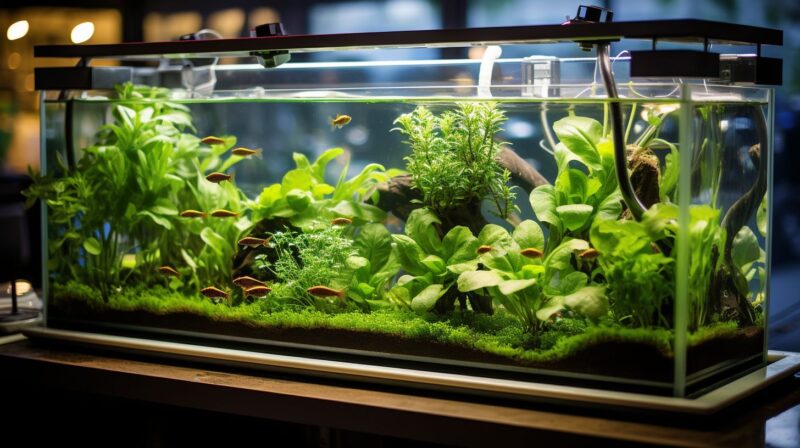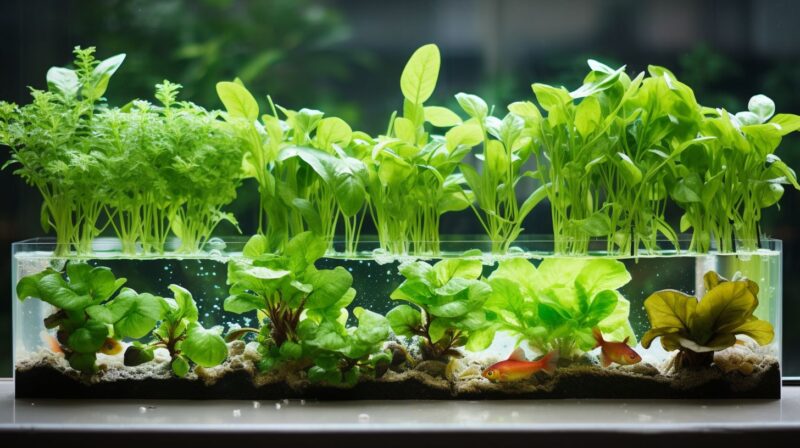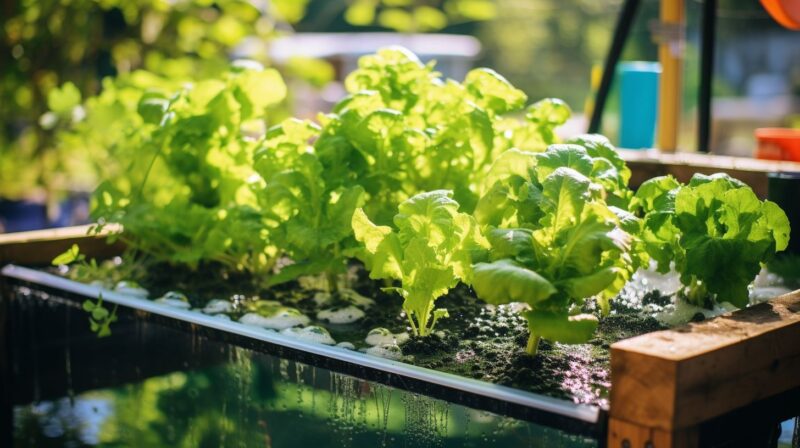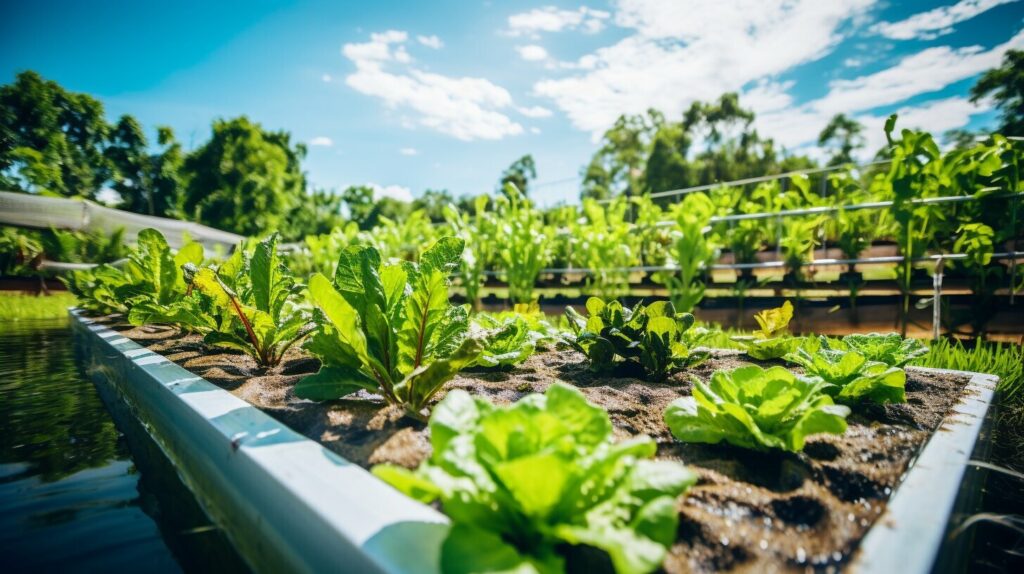This post may contain affiliate links and we may earn a small commission when you click on the links at no additional cost to you. As an Amazon Affiliate, we earn from qualifying purchases. You can read our full disclaimer here.
An aquaponics system may be the perfect solution to cultivate fresh produce and maintain healthy fish. This symbiotic system combines the principles of hydroponic system and aquaculture to provide a sustainable and efficient way to grow plants and breed fish.
However, routine care practices are essential to ensure your aquaponic system functions optimally. In this section, we’ll discuss the vital components of an aquaponics system, the importance of maintaining water quality, and the role of the filtration system in creating a conducive environment for plant growth.
Key Takeaways:
- Routine care practices are crucial for maintaining healthy aquaponics plants
- An aquaponics system combines hydroponics and aquaculture principles
- Water quality is essential for plant growth and fish health
- The proper functioning of a filtration system is crucial for an optimal plant growth environment.

Understanding Care Practices and Water Quality in Aquaponics
When it comes to aquaponics, ensuring healthy plant growth is just as important as maintaining the health of the fish. Understanding the key factors contributing to water quality is essential to help your plants thrive in this unique system.
Water Temperature
The water temperature of your system plays a critical role in plant growth and overall system health. Different types of plants have varying water temperature requirements, and neglecting this aspect can hinder their development. Some species of fish, such as tilapia, prefer warmer water, which may limit the type of plants you can grow. Therefore, it’s crucial to research what temperature range suits your fish species and the plants you want to grow.
Choice of Fish Species
The type of fish you choose to keep can also affect the success of your aquaponics system. Some species produce higher levels of waste, contributing to higher ammonia concentration and nitrogen levels in the water. This translates to a need for more frequent water changes. Therefore, it’s essential to consider the size and volume of your fish tank and research the potential impact of your chosen fish species on the plant’s growth.
Type of Aquaponics Plants in the System
The type of plants you grow in your aquaponics system can also affect the water. Some plants require less nutrient-rich water, while others may be sensitive to high nutrient levels. Choosing the right plants for your system and monitoring their nutrient levels can help avoid issues that may lead to stunted growth or plant death.
Overall, maintaining optimal water conditions in your aquaponics system is crucial to the growth and health of your plants. As such, it’s essential to monitor the water temperature, choose a suitable fish species, and select plants that can thrive in the nutrient-rich water your system provides.
Maintaining Proper Water Flow and Filtration
Now that you understand the basics of aquaponics and the importance of water quality, it’s time to focus on maintaining proper water flow and filtration. The plumbing system is crucial in ensuring efficient water circulation throughout the system. Make sure to check the pipes and connections regularly to avoid any clogging or leaking issues.
Proper maintenance of the filtration system is essential to maintaining the quality. The filtration system removes excess food, waste, and debris for a clean and healthy environment for plants and fish. A malfunctioning filtration system can result in the buildup of harmful chemicals and bacteria in the system that can harm your aquatic life.
Remember, the water usage in your aquaponics system is vital to maintain optimal standards. You want to ensure the water flows correctly through the system without stagnation or standing water. This can be achieved by installing a pump with appropriate flow rates.
To maintain the quality of water in your aquaponics system, you should also understand the basics of the system. Regularly monitoring pH, dissolved oxygen, and temperature helps maintain water purity and prevent health issues for plants and fish.
Proper maintenance of your aquaponics system’s plumbing and filtration system helps maintain cleanliness. Remember to monitor water usage, understand the basics of the system, and perform regular maintenance and checks to ensure that your system stays healthy and your plants and fish thrive.
Nutritional Needs of Aquaponic Plants
Providing optimal water conditions in aquaponics systems is crucial for cultivating healthy and thriving plants. One important factor to consider is the temperature of the water. Cool water helps ensure that the plants receive the necessary nutrients for growth.
A balanced diet is another critical aspect of nurturing healthy plants in your aquaponics system. Feeding your plants healthy foods, such as fish waste, helps them get the nutrients they need to thrive. It is important to note that providing your plants too much or too little can harm their growth and overall health.
In aquaponics systems, being aware of the potential risks of fish diseases and providing balanced nutrition to your plants is crucial. Keeping your fish healthy is essential to prevent harmful bacteria that damage plants. Regularly monitoring the health of your fish and maintaining optimal water conditions can help prevent fish diseases from developing in your system.
Overall, providing your aquaponic plants with optimal water conditions, a balanced diet, and preventing disease can help them grow healthy.
Troubleshooting Common Issues in Aquaponics Systems

Building and maintaining an aquaponics system can be a rewarding experience, but it’s not without its challenges. Here, we’ll explore some common issues you may encounter and provide tips on troubleshooting them. Whether you’re a seasoned aquaponics enthusiast or just starting, these insights will help you build and maintain a healthy and thriving system.
Water Quality Issues
Water that is too alkaline or acidic can harm both fish and plants. To fix this, test your water regularly and adjust your pH levels. You can also add buffer solutions to help maintain a stable pH balance. Proper water flow is also critical to maintain good hygiene.
Issues with the Fish Tank
Another common issue is related to the fish tank. If your fish is not thriving, you may need to check the water temperature, oxygen levels, and ammonia levels. If any of these are out of balance, they can harm the health of your fish. Ensure that your tank is suitable for the fish species you have chosen to keep. Also, overfeeding your fish can lead to excess waste, which can negatively impact the water standard and lead to fish diseases.
Challenges with Hydroponic Plants
If you’re having trouble with your hydroponic plants, ensure they receive adequate light, nutrients, and water. The proper pH levels should also be maintained for the plants to absorb nutrients efficiently. If you’re growing fruiting plants, ensure they have enough potassium and phosphate in the water. These nutrients are essential for fruit formation.
Building Your Own Aquaponics System
If you’re building your aquaponics system from scratch, you may encounter difficulties during the process. Some key factors to consider are the proper sizing of your system, the choice of plants and fish, and the materials used. Make sure you research and plan thoroughly before diving into your project.
You can maintain a healthy and flourishing ecosystem by troubleshooting common issues in aquaponics systems. Remember to keep a close eye on the states of the water and fish tank, monitor the growth of your hydroponic plants, and research before building your own aquaponics system. With these tips, you’ll be well on your way to a successful aquaponics experience.
Ensuring Fish Health and Water Conditions
When it comes to maintaining a healthy aquaponics system, it’s important not to overlook your fish’s health and water condition. The grow bed is vital in supporting your fish and plants, and proper maintenance is essential to ensure optimal growth.
To help prevent any issues with your fish, providing them with adequate fish food and maintaining appropriate oxygen levels is necessary. Oxygen is vital for fish health. Regular feeding provides essential nutrients.
The plants in your aquaponics system also have specific needs that must be met. The grow bed can help provide the necessary nutrients. Still, it’s also vital to ensure suitable water conditions. Plants need balanced pH and nutrient levels to develop correctly, so monitor these levels regularly.
Proper water flow is essential for maintaining healthy pet friends, as stagnant water can create an environment for harmful bacteria to thrive. To help prevent this, ensure your water circulates properly through your filtration system and any debris is removed as needed.
Regular maintenance of your aquaponics system is also essential to ensure it stays clean and healthy. This involves maintaining the grow bed, monitoring hydric health, and making necessary adjustments to provide fish and plant health and happiness.
Overall, keeping your fish and plants healthy in your aquaponics system is a combination of providing them with the nutrients and conditions they need to thrive. By monitoring the oxygen levels, fish food, and water purity, you can help prevent any issues and ensure your aquatic ecosystem functions properly.
Maintaining Water Quality and Balance

Regarding aquaponics, the health of your fish and plants depends on the quality and balance of the water in your system. Fish waste is one of the most significant factors affecting the aquatic environment. Excess waste can quickly accumulate and create an unhealthy environment for your fish. Therefore, it is essential to regularly check and remove any debris that may have accumulated in the system.
Adequate water flow is also crucial for the health of your fish. Proper water circulation helps distribute oxygen and nutrients throughout the system while removing excess nutrients. A lack of adequate water flow can create dead zones in the system, leading to poor standards of the aquatic medium and endangering the health of your fish.
Clean water is imperative to maintain the health of your fish and plants. You can ensure clean water by routinely checking and adjusting the pH levels and maintaining appropriate water temperature. Regular water changes are also necessary to prevent harmful substances from building up in the system.
Checking the Health of Your Fish
The quality of your aquaponics system has a direct impact on the health of your fish. A well-maintained system with balanced aquatic health prevents diseases and promotes healthy growth. Regularly check the oxygen levels and water temperature to ensure they are optimal for the species of fish you are keeping.
Overfeeding your fish can also result in poor water integrity and endanger their health. Be mindful of how much food you feed your fish, and remove any uneaten food to prevent it from decomposing in the system.
Maintaining the proper water flow, regular cleaning and water changes, and monitoring the health of your fish will help maintain balance and improve water quality in your aquaponics system. You can enjoy healthy and happy fish and plant growth with a well-maintained system.
Managing Bacteria Levels and Preventing Toxicity
Managing bacteria levels is critical in ensuring the health and well-being of your aquaponics system. While beneficial bacteria are necessary to convert fish waste into nutrients for your plants, excessive bacteria can be toxic to fish and negatively impact water quality. It is, therefore, essential to maintain a healthy balance of bacteria in your system.
To help maintain the right balance of bacteria, regular maintenance is essential. Check the water quality regularly to ensure optimal pH levels. You may also want to consider using a microbial additive to keep the levels of good bacteria high and prevent harmful bacteria from taking over.
It’s important to note that not all bacteria are harmful. Beneficial bacteria play a vital role in preventing the accumulation of toxins by decomposing organic materials. However, if bacteria levels get out of control, it can quickly become a problem. Look for any signs of toxicity, such as discolored water, sick fish, or foul odors.
Suppose you do detect a problem with bacteria levels. In that case, there are several things you can do to help prevent it from becoming toxic to fish. One option is to increase aeration in the system to improve oxygen levels, which will help to decrease the chances of bad bacteria forming. You may also consider adding a UV sterilizer to the system.”
Conclusion
Congratulations on learning about routine care practices for maintaining healthy aquaponics plants. Remember that water conditions are key, and regular water changes go a long way in keeping your plants fruiting and happy.
As discussed, a healthy and productive aquaponics systems require consistent attention and maintenance to ensure healthy fish and plants. Don’t forget to check your plants’ water quality, flow, filtration, and nutritional needs. Troubleshooting common issues, managing bacteria levels, and preventing toxicity are crucial to remember.
By following these tips and incorporating them into your regular maintenance routine, you can enjoy healthy and thriving aquaponics plants all year round.



